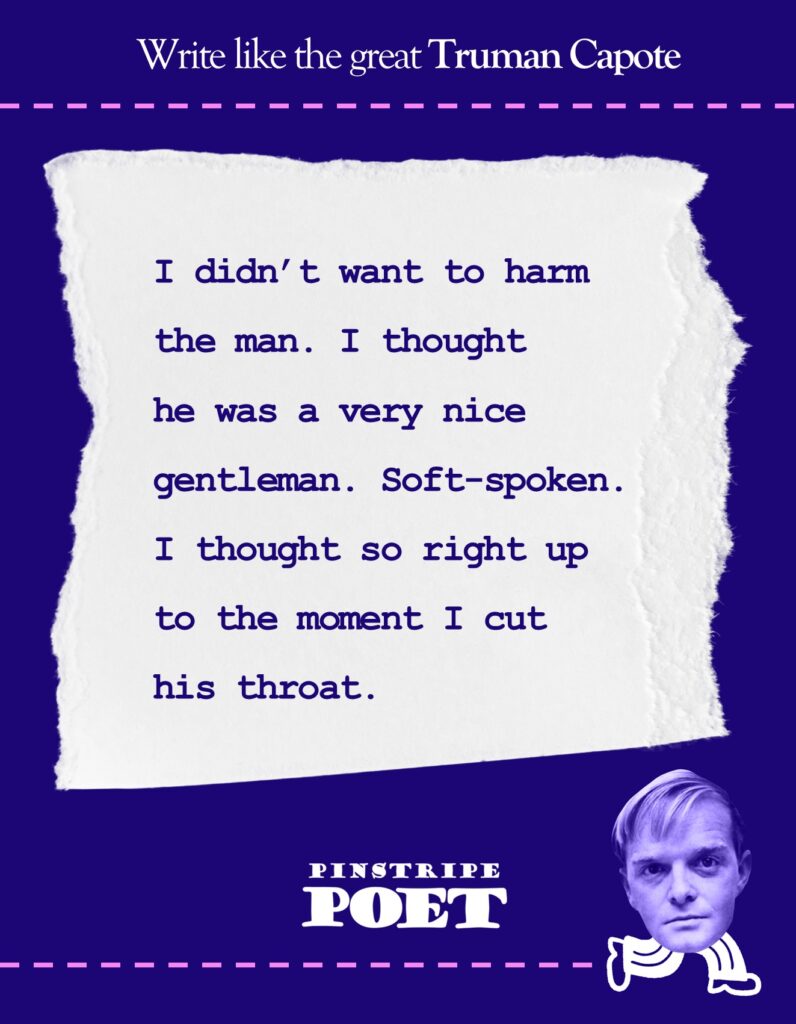
True crime. Popular since Cain brained Abel.
So let’s make room for the genre and its tensions and its foibles.
Let’s talk about two dramas. One serialised on Netflix. The other in The New Yorker, 60 years prior.
Richard Gadd spilt his guts
Baby Reindeer was mandatory viewing in 2024. Richard Gadd played himself, reliving the abuses he’d suffered as an aspiring comedian.
The title was absurd and chilling. It was the pet name pinned to Gadd by his stalker. It featured in thousands of messages.
I need a ncie boy totake care of me, he who looks likea baby reindeer
Gadd was haunted at work, at home, online.
His stalker sent 46 Facebook messages, 744 tweets, 41,076 emails.
don’t thnk ill stop baby reindeer
She recorded pleading, abusive, explicit monologues to Gadd’s voicemail. 350 hours in total.
He could’ve listened to his stalker for two whole weeks. And the remarkable thing was…
… he did.
Gadd reviewed his stalker’s raving, so he could devise a one-man show:
I remember during a particularly long night of unrest, the idea came to me. To stage this whole ordeal, one day, when the time was right.
What an opening it might be to layer the voicemails on top of one another and shoot them around a stage in a wash of projected light …
[W]hat better way to start a show than to plunge the audience straight inside the horror of it all?
Baby Reindeer struck the Edinburgh Fringe, then struck a deal with Netflix. Streaming hauled the case into the public consciousness.
nauty boys wil be punishded
It featured real emails. Real texts. We could read them for ourselves. And each episode opened with the claim:
This is a true story
Extraordinary — but precedented. The novel In Cold Blood, published in 1966, was subtitled:
A True Account of a Multiple Murder and Its Consequences.
Truman Capote let them hang
Back in time, Capote was coaxed from the comfort of New York by the scent of slaughter.
It issued from a farmhouse in Kansas. This was 1959. The New York Times ran the story:
Wealthy Farmer, 3 of Family Slain
It came deep inside the paper, but caught the writer’s eye. Capote recalls:
[A]fter reading the story it suddenly struck me that a crime, the study of one such, might provide the broad scope I needed to write the kind of book I wanted to write.
The kind of book Capote wanted to write was a ‘non-fiction novel’ — a concept he’d been turning over in his mind, until it was worn as a beachcombed pebble.
What would it mean to make art out of reality? Would journalism change if given three hundred pages rather than a single spread?
Like Gadd, Capote couldn’t begin his work until he was drowned in material:
My files would almost fill a whole small room, right up to the ceiling. All my research. Hundreds of letters. Newspaper clippings. Court records–the court records almost fill two trunks.
Visit the writer’s archive and you can leaf through 14 folders, run your finger along timelines, smooth the creases from hand-drawn maps.
And amongst it all, quotes from the people of Kansas, full of winsome rural wisdom:
I don’t see how anyone can sit down to table without wanting to bless it.
Contrast that with the cynicism of the feckless killers, also recorded by Capote’s steel mind:
I believe in hanging. Just so long as I’m not the one being hanged.
Those quotes are as characterful — and as revealing — as the voicemails on Gadd’s mobile.
Well, visiting hours are almost over at the archive. You’ve just enough time to skim the press galleys of In Cold Blood. And I have to turn your attention to the notes in the margin.
Capote’s editor at The New Yorker was fretful. In one place he scribbled:
A device needed for author to account for his knowing what was said in private conversations
In another, simply:
How know? No witnesses? General problem
Yes, Capote’s omniscience was a problem
The veracity of In Cold Blood has been contested since the year it was published.
A reporter from Esquire spoke to the same Kansas residents as Capote — and found their recollections differed from the words Capote plopped in their mouths.
No surprise. Given Capote interviewed without tape machine or notepad. He relied on his prodigious memory to preserve the testimonies of waitresses and farmhands.
The Esquire reporter concluded:
By insisting that ‘every word’ of his book is true he has made himself vulnerable to those readers who are prepared to examine seriously such a sweeping claim.
And that’s another reason to treat In Cold Blood as a precursor to Baby Reindeer, as Netflix came to regret the promise that they were telling a true story.
The art of non-fiction narrative is fraught
Gadd manipulated events to manage his audience’s interest, fixing them to the sofa as the series rolled on:
[A] lot of stalking is quite boring at times, like it’s a repetitive action and it’s, ‘Oh god, this person’s messaging again.’ And of course, in television, especially a thriller, you need to move certain timelines around, you need to move certain points to the end of episodes to make them pay off a little better.
Capote’s serial was also gripping. But it had the qualities of a fable too. By massaging the details of the murder (such as amplifying the folksiness of Holcomb farmers), Capote could depict two contrasting visions of America:
[T]his collision between the desperate, ruthless, wandering, savage part of American life, and the other, which is insular and safe, more or less.
There was something bigger at stake.
Gadd made similar arguments: he was reaching for a more essential story. And he was worth listening to as someone who was simultaneously victim and author, researcher and subject.
The skeleton of the story is absolutely true.
As for Capote, he came close to admitting the true nature of his masterwork. After seeing the 1967 movie adaptation of In Cold Blood, he wrote:
Reflected reality is the essence of reality, the truer truth…
Aidan Clifford writes for Pinstripe Poets – artists who love their day jobs. This post is part of a series called ‘Write like the Greats’. See the rest here.


